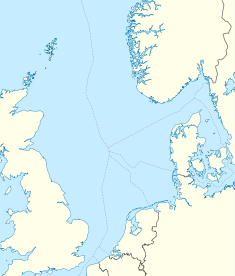Cormorant oilfield
This article needs additional citations for verification. (December 2009) |
| Cormorant oilfield | |
|---|---|
| Location of Cormorant oilfield | |
| Country | Scotland, United Kingdom |
| Region | Shetland basin |
| Block | 211/26a |
| Offshore/onshore | Offshore |
| Coordinates | 61°06′9″N 1°4′22″E / 61.10250°N 1.07278°E |
| Operator | TAQA Bratani |
| Field history | |
| Discovery | September 1972 |
| Start of production | 1979 |
| Peak year | 1979 |
| Production | |
| Estimated oil in place | 90 million barrels (~1.2×107 t) |
| Estimated gas in place | 600×109 cu ft (17×109 m3) |
The Cormorant oilfield is located 161 kilometres (100 mi) north east of Lerwick, Shetland, Scotland, in block number 211/26a. It was discovered in September 1972 at a depth of 150 metres (490 ft). Estimated recovery is 90 million barrels (14×106 m3) of oil. The oil reservoir is located at a depth of 2,895 metres (9,498 ft).
Ownership
Originally, it was operated by Shell and licensed to Shell/Esso. On 7 July 2008, it was purchased by Abu Dhabi National Energy Company.[1][2]
Production
Production started in December 1979 from the Cormorant Alpha platform. This platform is a concrete gravity platform of the Sea Tank Co type. It has four legs and storage capacity for 1 million barrels (160,000 m3) of oil. The total sub-structure weight is 294,655 tonnes and it is designed to carry a topsides weight of 32,350 tonnes.
The topsides facilities included capability to drill, produce, meter and pump oil. It also has capability to re-inject water to maintain reservoir pressure. Peak production was 24,000 barrels per day (3,800 m3/d) in 1979. The platform is also the starting point for the Brent System pipeline, a major communications centre and the location of Brent Log - air traffic control for Northern North Sea helicopter traffic.
The topsides for Cormorant Alpha were designed by Matthew Hall Engineering which was awarded the contract in October 1974.[3] Initially there were facilities for 17 oil production wells, 18 water injection wells and one gas injection well. The production capacity was 60,000 barrels of oil per day and 900,000 standard cubic metres of gas per day. There was a single production train of three stages of separation with the first stage operating at a pressure of 30 barg. The 16 subsea storage cells had a capacity of 600,000 barrels. Electricity generation was powered by one 12 MW Rolls Royce Avon gas turbine and four 2.5 MW Solar Mars gas turbines. The topside accommodation was for 200 people. There are 16 topsides modules and the topsides weight was 25,000 tonnes.[3]
In addition an Underwater Manifold Centre (controlled from the Cormorant platform also produces oil. This started up in mid 1983. It has a design capacity for 50,000 barrels per day (7,900 m3/d). The UMC lost communications several years ago but a project ongoing in 2006 is looking to produce from the UMC once again. Also a single satellite well (P1) is linked to the platform with a design capacity of 10,000 barrels per day (1,600 m3/d).
Natural gas is exported from Cormorant Alpha via the Vesterled gas pipeline which connect into the FLAGS pipeline at Brent Alpha to St Fergus Gas Terminal.
Accidents
A Norwegian organisation states that the Cormorant A platform almost sank in 1977 during its construction in Norway. This was disputed in a TV documentary on 7 May 2007.
Reported by IPA as occurring 3 March 1983, Cormorant Alpha Platform,[4]. There were 3 in total killed in this explosion and following fire. 2 killed outright (blown against a set of Scaffolding opposite the door on the production deck they entered the module by) Another died of Burns a week or so later in hospital. The Treasure Finder (shuttle Accommodation, hospital and 2 helli-decks), was parked midway between Cormorant Alpha and the Cormorant North, then lifted anchor and steamed over ready for evacuation, standing off about 500 yards.[citation needed]
The Cormorant Alpha crew waited inside the safe accommodation area for 2-3 days while the weather remained too bad for general helicopter evacuations, and eventually stood down and back to work a week or so later.[citation needed]
On 16 January 2013 and again on 2 March 2013 a hydrocarbon leak in one of the legs of the platform was reported. Personnel were evacuated from the platform and the Brent System was closed down, however no oil had been spilt into the sea.[5] Many environmental groups called for the UK and Scottish governments to regulate the industry and the "aging" platforms more closely.
See also
References
- ^ "Abu Dhabi national energy company pjsc (taqa) agrees to purchase north sea assets from shell u.k. ltd and esso exploration and production u.k. ltd". Al Bawaba. 7 July 2008. Retrieved 21 March 2009.
- ^ Lin Noueihed (7 July 2008). "Abu Dhabi's Taqa buys Shell, Exxon North Sea interests". Reuters. Retrieved 9 February 2010.
- ^ a b Matthew Hall Engineering publicity brochure n.d. but c. 1990
- ^ https://www.upi.com/Archives/1983/03/03/A-fiery-explosion-rocked-a-North-Sea-oil-rig/2506415515600/
- ^ "UK Brent oil system still shut after Cormorant leak". Reuters. 3 March 2013. Retrieved 3 March 2013.

